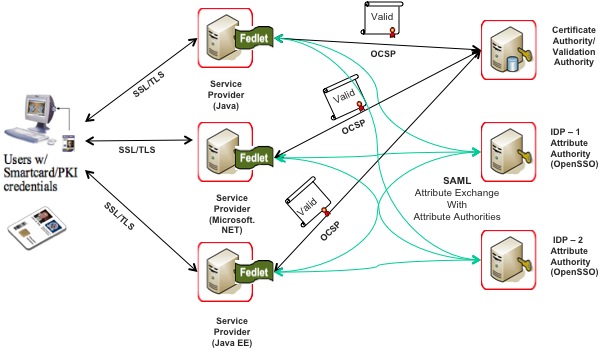In a typical Single Sign-On (SSO)/Federation scenario using SAML, the Service Provider (SP) initiates the user authentication request using SAML AuthnRequest assertion with an Identity Provider (IDP). The IDP authenticates the principal and returns a SAML AuthnStatement assertion response confirming the user authentication. If the user is successfully authenticated, the SP is required to have the subject’s profile attributes of the authenticated principal for making local authorization decisions. To obtain the subject’s profile attributes (ex. organization, email, role), the SP initiates a SAML AttributeQuery request with the target IDP. The IDP returns a response SAML AttributeStatement assertion listing the name of the attributes and the associated values. Using the subject’s profile attributes, the SP can perform authorization operations.
Ofcourse, it looks simple…here is the complexity – Last two weeks I spent on building a Proof-of-Concept that conforms to HSPD-12 Back-end Attribute Exchange specifications and SAMLv2 Attribute Sharing Profile for X.509 Authentication based systems (Both specifications are mandated as part of Federal Identity, Credential and Access Management (ICAM) initiative of Federal CIO Council). I had been experimenting with an Identity Federation scenario that makes use of Smartcard/PKI credentials – Card Authentication Key (CAK)/X.509 Certificate on a PIV card authenticates a PKI provider (using OCSP) and then using its X.509 credential attributes (Subject DN) for looking up off-card user attributes from an IDP (that acts as an Attribute Authority). The IDP provides the user profile attribute information to the requesting SP. In simpler terms, the SP initiated X.509 authentication directly via OCSP request/response with a Certificate Validation Authority (VA) of a Certificate Authority (CA). Upon successful authentication, the SP initiates a SAML AttributeQuery to the IDP (which acts as an Attribute Authority), the SAML AttributeQuery uses the SubjectDN of the authenticated principal from the X.509 certificate and requests the IDP to provide the subject’s user profile attributes.
Using Fedlet for SAML X.509 Authentication based Attribute Sharing
Fedlet is a lightweight SAMLv2 based Service Provider (SP) implementation (currently part of Sun OpenSSO 8.x and sooner to be available in Oracle Identity Federation) for enabling SAMLv2 based Single Sign-On environment. In simpler terms, Fedlet allows an Identity Provider (IDP) to enable an SP that need not have federation implemented. The SP plugs in the Fedlet to a Java/.NET web application and then ready to initiate SAML v2 based SSO authentication, authorization and attribute exchanges. A Fedlet installed and configured with a SP can set up to use multiple IDPs where select IDPs can acts as Attribute Authorities. In this case, the Fedlet need to update its configuration with the IDP Metadata configuration (such as entity ID, IDP Meta Alias, Attribute Authority Meta Alias – same as IDP ). In addition, the Fedlets are capable of performing XML signature verification and decryption of responses from the IDP must identify the alias of signing and encryption certificates.
Here is the quick documentation, which I referred for putting together the solution using Fedlets for SAMLv2 Attribute Sharing for X.509 based authentication scenarios. In case, if you want your Service Provider to use OpenSSO for PIV/CAC based certificate authentication, you may refer to my earlier entry on Smartcard/PKI authentication based SSO (Using OpenSSO). Besides that you should be good to test-drive your excercise. Ofcourse, you can use Fedlets for Microsoft .NET service providers but it was’nt in my scope of work !
In case of SP requiring to fetch multiple user profile attributes you may also choose to use SPML based queries (SPML Lookup/Update/Batch Request/Response) to an Identity Manager (acting as Attribute Authority) – assuming it facilitates an SPML implementation). If you are looking for a solution that requires user profile attributes after a single-user X.509 authentication, then SAML Attribute query should help fetching a single user profile of an authenticated principal !
🙂

Ramesh,
Excellent work.
Did you use Glassfish Enterprise as your container, assuming you used NSS as the keystore ? Would you send me privately the FIPS-140 mode config. I appreciate the help.
Thanks
Will
Pingback: SAML Attribute Exchange for X.509 Authentication based Identity Federation | Online REL
Ramesh,
Interesting example.
Any particular reason why you choose the card authentication certificate here? Also I think there are some options around the binding of the attributes (which is what SAML is all about) including the ability to write them to the credential (not allowed under PIV but someday…easier in PIV-I (+)enterprise).
Hope summer is treating you well and I look forward to catching up.
Sal
Ramesh,
Excellent and Interesting post. But the quick documentation link for “Using Fedlets for SAMLv2 Attribute Sharing for X.509 based authentication scenarios” is not available now. Do you have the document available else where ? If yes, that’s going to help me a lot..
Thanks in advance !